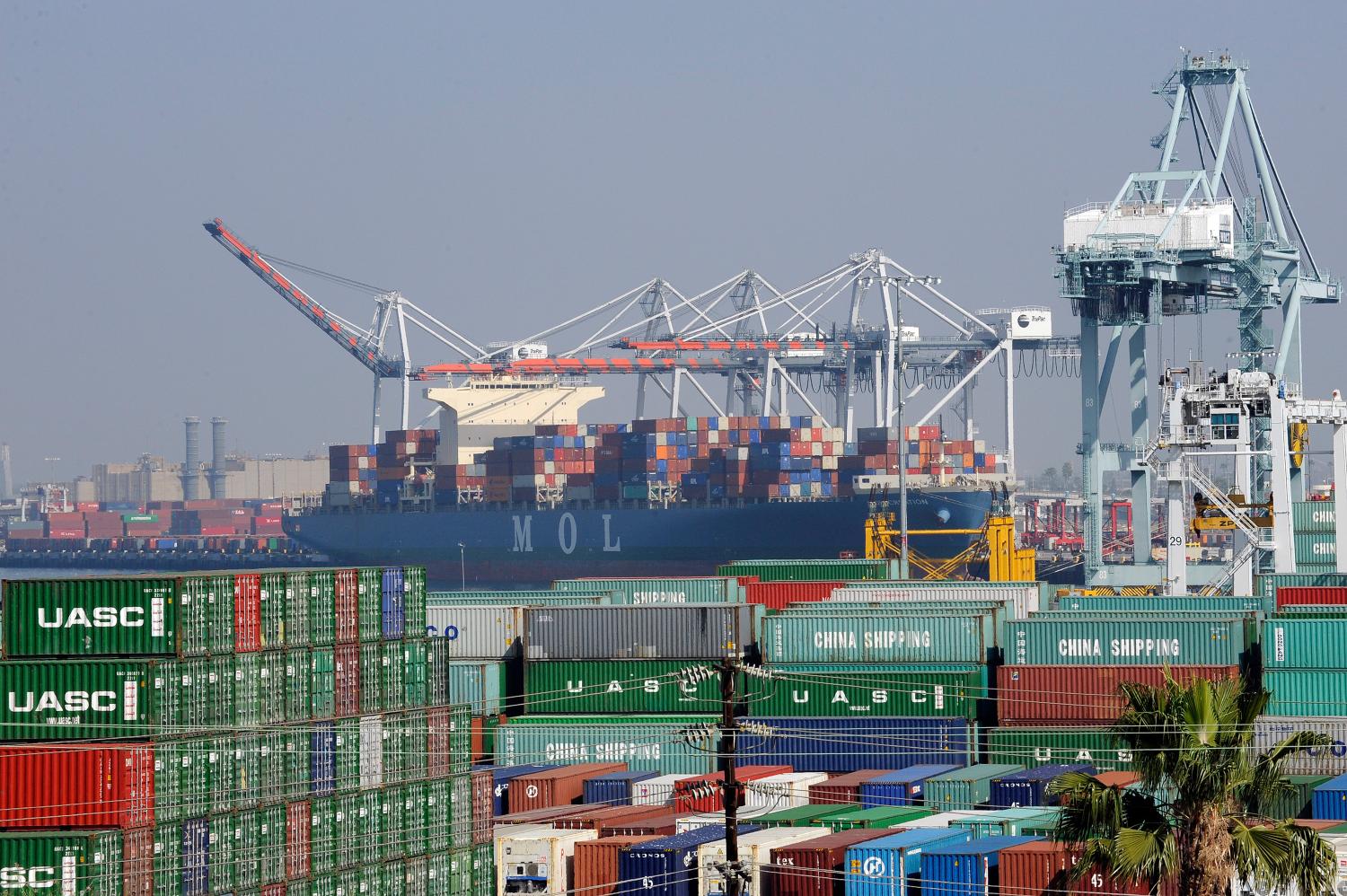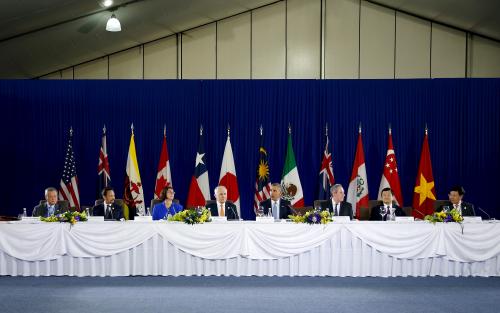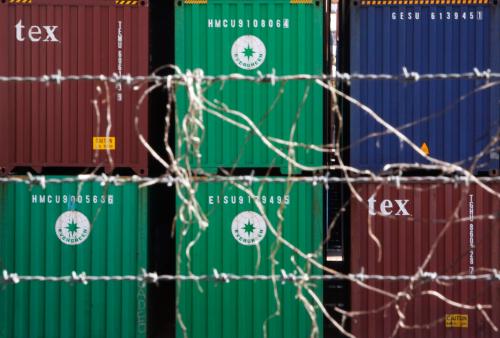The following brief is part of Brookings Big Ideas for America—an institution-wide initiative in which Brookings scholars have identified the biggest issues facing the country and provide ideas for how to address them. (Updated January 24, 2017)
The United States is confronted with a defining issue: are we to turn inward by questioning the economic benefits of trade, reneging on a major diplomatic success in updating multilateral economic disciplines, and failing to renew a rules-based order at a time of a profound power shift in Asia? More important, is the abdication of international leadership good for the American worker? How does the Trans-Pacific Partnership (TPP) match up with U.S. visions of prosperity, security, and governance—and what will be needed to renew U.S. support for international economic engagement?
Trade and the National Interest
Prosperity
Trade’s main contribution to national wealth comes from enhancing competitiveness. Building on the forces of specialization and innovation, open markets allow for the most efficient use of productive resources, foster competition to dismantle monopolies and inflated prices, and help disseminate new ideas and technologies that propel future growth. At the most fundamental level, an open trade regime allows nations to escape the boundaries of their internal markets to service global demand. The empirical record across centuries and regions is unequivocal: nations that purposively avail themselves of the international marketplace outperform those whose sights remain constrained by national boundaries.1
One of the major contributions of free trade is the reduction in the cost of living for consumers by making available goods and services at a lower cost. This price reduction in everyday necessities is particularly important for consumers with the fewest resources. Tariff elimination has a pro-poor bias in every country. For example, a modeling exercise shows that a move toward autarky in the world would erode the purchasing power of consumers across all income brackets, but it would bring an outsize loss (over 60 percent) for consumers at the bottom of the distribution ladder.2
International trade, like all forces of economic change, both creates and destroys jobs. Sectors that enjoy international competitiveness will thrive, creating job opportunities, but those that are unable to meet competition from abroad will contract and cut back on employment. Both sides of the coin matter in assessing trade’s impact. The job benefits of international trade for the U.S. economy are substantial. In 2014, exports sustained 11.6 million jobs3—a conservative estimate that does not take into account the job creation effects of imports (for example, the sourcing of foreign components that make user industries more competitive), and of foreign direct investments in the United States that result from operating an open and competitive economy. But the figure suffices to show that export activity benefits working Americans, especially considering that wages in the export sector are 18 percent higher on average.
Jobs supported by goods and services exports in 2014:
 Source: “Jobs Supported by Exports 2014: Product,” International Trade Commission, U.S. Department of Commerce, July 2016, http://www.trade.gov/mas/ian/build/groups/public/@tg_ian/documents/webcontent/tg_ian_005507.pdf.
Source: “Jobs Supported by Exports 2014: Product,” International Trade Commission, U.S. Department of Commerce, July 2016, http://www.trade.gov/mas/ian/build/groups/public/@tg_ian/documents/webcontent/tg_ian_005507.pdf.
Trade liberalization also destroys jobs, and the costs for affected workers are steep. Trade competition with China (which is not a signatory to a trade agreement with the United States) is estimated by some to have cost 985,000 manufacturing jobs between 1999 and 2011, at a time when U.S. manufacturing employment fell by 5.8 million jobs. And contrary to the notion of fluid labor markets, displaced American workers have not easily bounced back, as they have been saddled by prolonged spells of unemployment or left the workforce entirely, and when reemployed they frequently have settled for lower pay.4
No finding has framed more the current debate on the merits of trade for the American worker than the “China trade shock” thesis.5 These findings point to the need to incentivize China to reform its trading and investment practices, and the TPP in fact can play an important role to this end.6 Moreover, they have cast the spotlight on what is our biggest policy mistake: to leave unabated the distributional costs of economic change writ large as a result of both technological change and trade liberalization.
However, the wrong conclusion drawn by antitrade critics is that by trading with China we have surrendered our economic strength and self-imposed deindustrialization, and that protectionism will bring manual jobs back. The predominant cause for the loss of manufacturing employment has been technological change (85 percent), not international trade.7 Automation has transformed the American factory, rendering millions of low-skilled jobs redundant. That technology is the primary driver is corroborated by the fact that despite the steep decline in factory jobs, manufacturing leads the U.S. economy in productivity rates and industrial output has been growing. Efforts to take stock of the contributions of trade with China to the American economy must certainly weigh in the job loss of rising import penetration, but must also factor in the jobs supported through American exports of goods and services to China, and the millions of consumers who have access to lower-priced goods. Protectionist measures could cost millions of Americans their means of livelihood.8
The TPP represents a different balance of benefits and costs with sizable economic gains from trading with a group of like-minded countries adopting cutting-edge rules and smaller adjustment costs (the largest market the TPP opens for the United States is a high-wage economy, Japan) and with important geopolitical ramifications. With novel rules on the digital economy, high tariff elimination targets, and disciplines to address behind-the-border protectionism, the TPP creates opportunities for American sectors that enjoy competitive strength—services, advanced manufacturing, and agriculture. The U.S. International Trade Commission estimates a net positive (albeit small) effect of TPP on job creation (128,000 jobs) and an increase in real wage rates (0.19 percent) by 2032. Annual increases in real income for Americans (that is, an expansion in their purchasing power) range from $57 billion to $131 billion by 2032.9
Security
As a region characterized by both its unparalleled economic dynamism and the rise of an emerging power with global aspirations, Asia is an area of vital security interests for the United States. The strategic goals of U.S. trade diplomacy in the region are in fact straightforward:
- To partake in the growth dividend of Asia-Pacific integration as a means of national strengthening, but also to reap the influence benefits that come from deepening links of shared prosperity with common view partners;
- To update and disseminate rules that shore up a liberal trading order that reflects not only our economic and security interests but also our values;
- To strengthen reforming elites who want to use international commitments to gain leverage in advancing economic reforms toward more open economies;
- To reassure allies and rivals that the United States is a multidimensional power, fully anchored to the region and capable of supplying novel institutions for regional cooperation; and
- To develop a smart strategy vis-à-vis China’s regional and global leadership bid by using trade policy in proactive ways (covering governance gaps) and inclusive ways (contemplating a future Chinese accession).
The United States can meet these goals through the TPP, but if it scuttles the trade deal there is no other diplomatic instrument that can advance these vital security interests in one fell swoop. If clout is defined by the existence of alternatives, the United States will be at a disadvantage. Both our partners and competitors have a Plan B if the TPP never materializes. This plan is not a lofty blueprint for a distant future. It is ongoing trade negotiations to establish a 16-nation East Asian trade grouping: the Regional Comprehensive Economic Partnership (RCEP) led by China.

It should be recalled that the United States joined the TPP negotiations to avoid being marginalized from the process of Asian regionalism, as countries there drafted plans for trade integration that did not include us. Now, we seem poised to deliver that precise outcome ourselves. The security challenge is not that China is flexing its muscle to establish an alternative trading regime, it is that we are handing China the leadership baton. To look at it another way, think about the reach and meaning of RCEP in alternative scenarios where the TPP is enacted or not. In the former, RCEP is a conventional trade agreement that is thin on rules and shields only the most sensitive sectors; in the latter, RCEP becomes the regional standard of economic integration and elevates China as the focal point of economic diplomacy—with a novel institutional portfolio to cover a wide array of policy arenas from trade to infrastructure finance. The intervening variable is vanishing U.S. leadership.
Governance
One of the least understood aspects in the public debate on trade policy is why trade negotiations are no longer solely or even principally about tariff elimination, but about rules on policy arenas behind the border. The nature of trade negotiations has been transformed by the reorganization of international production activities and the consequent change in patterns of foreign trade. Traditionally, trade was driven by the exchange of finished goods, but the dissemination of global value chains (where production is fragmented and dispersed across national boundaries) means that the exchange of components, machinery, and services represents more than two-thirds of the value of international trade. Two main policy implications should be readily apparent. One, imports are ever more essential to sustain export activities, making protectionism costlier. And two, leveraging the growth potential of the global value chain calls for international trade disciplines that match the reality of international trade operations. But we have yet to codify them at the multilateral level, given the dysfunction of the World Trade Organization.
Trade negotiations have become infinitely more complex and challenging. To the traditional concern with market access (which remains a central objective), we need to add the new market presence agenda. In other words, deep integration disciplines provide commitments on the liberalization and protection of foreign direct investment, on the internationalization of services and free cross-border data movements, on the protection of intellectual property, and on competition policy and rule of law that facilitate the operation of the global factory.10 The TPP aims to close this governance gap. It places a different kind of bet: that by shifting the locus of negotiation to a cluster of countries willing to undertake far-reaching liberalization and to codify novel trade and investment rules, the momentum for trade liberalization can be sustained. This bet could not be more timely, given the marked slowdown in international trade growth in the years after the global financial crisis.
Trade policy is vitally connected to core national interests of enhancing economic competitiveness, anchoring our leadership role in Asia, and renewing a liberal economic order. But our leadership on trade is predicated on a much-needed domestic transformation—one that puts front and center a better distribution of economic opportunity.
Cultivating the Politics of Openness
With the above context in mind, what can be done to recreate a domestic consensus on the benefits of international trade that will pave the way for trade agreements, such as the TPP, that advance our national interests and have a positive influence on jobs and wages?
Make the case for trade differently, and act accordingly
A more compelling case will build from the insight that people who have not benefitted from economic change will naturally oppose it.
The case for trade has been made by focusing on the potential gains of more open competition while downplaying the concurrent fears, whether because the adjustment costs are deemed relatively small or because the United States will have assistance programs for trade-impacted workers. But these arguments do not resonate in a context of marked increases in income inequality or with still-fresh memories of significant job losses when the economy was battered by the global financial crisis. A more compelling case will build from the insight that people who have not benefitted from economic change will naturally oppose it. It will make the case for liberalization with a laser focus on the issue that the public cares most about: jobs. This means making a U-turn from the classic economists’ position: that jobs are a side issue in assessing the merits of trade because the economy will return to full employment in the long run, and that the gains from trade are supple enough to compensate losers.
It is possible to focus on jobs and make a robust case for trade, to underscore that we have a more fundamental problem at hand with the growing skills deficit in the workforce that cannot be solved by blaming liberalization, and to grasp that a protectionist turn will not bring old-economy jobs back but will kill both today’s and tomorrow’s jobs. By looking at the jobs figures, we can:
- Put the impact of trade on jobs in perspective: the mammoth size of the U.S. labor market (121 million full-time jobs in 2015) and its active churning (5.2 million hires and 4.9 million separations in a single month—July 2016);11
- Understand the much larger impact that technological change has had on the loss of manufacturing jobs in the course of a decade compared to trade with China: 4.815 million vs. 985,000, respectively;
- Realize the value of export activity to working Americans: 11.6 million jobs in the export sector in 2014 (951,000 jobs in exports to China);
- Grasp the job casualties of protectionism: 4.8 million jobs in 2019 in a full trade war scenario;12 and
- Realize the enormous wasted opportunities of a growing skill mismatch and labor market rigidities: 5.9 million unfilled job openings in July 2016.
Transform U.S. labor markets from flexibility to mobility
Just as rehashing our arguments on the gains from trade will accomplish little, so will doubling down on existing Trade Adjustment Assistance programs. Currently, these programs cover only a section of American workers, have not effectively tackled the problem of wage erosion, have come short in providing effective training, and cannot tend to the larger needs of skill acquisition for the American workforce. Instead, we need a comprehensive and proadjustment safety net that allows all displaced workers to navigate difficult economic transitions brought about by technological change, trade liberalization, and/or macroeconomic shocks. Job dislocation imposes a heavy toll on affected workers. The challenge for laid-off workers in finding new employment at a comparable wage is steep, and it may compromise their lifelong earnings potential. A skill mismatch may also prevent the redundant workers from transitioning to new economic sectors with growth potential. Furthermore, job competition among redundant workers will be particularly steep during recessions, triggering high unemployment rates, mass layoffs in a specific industry, and in situations where limited geographical mobility hinders relocation from depressed communities, dire employment prospects.
American labor markets are well known for their flexibility in firing and hiring workers, but this trait alone is not sufficient to generate smooth adjustment. Policies that target labor mobility are required to enable workers to relocate geographically and to enter new occupations and fields. The foundation of this mobility will be skill acquisition and upgrading. A relaunched safety net must embrace and invest in active labor market policies that increase the employability of workers through training, job-search assistance, direct job creation, and employment incentives. Concrete initiatives include:
- An expansion of the Earned Income Tax Credit for lower-income workers by loosening eligibility criteria;
- An extension of the wage insurance program to cover all workers (not just people over 50 enrolled in Trade Adjustment Assistance programs), since this income supplement tackles the pervasive problem of wage erosion;
- Dedicated community college funding to allow individuals to acquire or retool their skills to become more employable;
- An increase in the number of apprenticeships that provide company training and a potential path to future employment; and
- Job opportunities in rebuilding our deteriorating infrastructure, for workers who are unlikely to shift occupations through new skills.
A secure middle class and investments in human capital are essential to the renewal of U.S. internationalism and our leadership in trade. Succumbing to protectionism will leave workers’ needs unattended and make us all worse off.
Acknowledgments: I greatly benefited from comments on an earlier draft from my Brookings colleagues: David Dollar, Kenneth Lieberthal, Joshua Meltzer, and Michael O’Hanlon. This policy brief also appeared in the Brookings Order from Chaos, Asia Working Group paper series.
-
Footnotes
- World Economic Forum, “The Case for Trade and Competitiveness,” September 2015, www3.weforum.org/docs/WEF_GAC_Competitiveness_2105.pdf.
- Pablo D. Fajgelbaum and Amit K. Khandelwal, “Measuring the Unequal Gains from Trade,” Quarterly Journal of Economics 131, no. 3 (2016): 1113–80, doi: 10.1093/qje/qjw013.
- “Employment and Trade,” International Trade Administration, Department of Commerce, last modified September 22, 2016, www.trade.gov/mas/ian/employment/.
- David H. Autor, David Dorn, and Gordon H. Hanson, “The China Shock: Learning from Labor Market Adjustment to Large Changes in Trade,” Working Paper 21906 (Cambridge, Mass.: National Bureau of Economic Research, January 2016), www.nber.org/papers/w21906.
- Not every economist agrees that imports from China have had such ravaging effects on U.S. manufacturing jobs. Martin Baily and Barry Bosworth note that structural changes in the U.S. economy resulted in a contraction of the share of manufacturing employment over the span of decades. This long-term trend combined in the 2000s with sluggish job creation to produce an absolute decline in factory jobs. See Martin Baily and Barry Bosworth, “U.S. Manufacturing: Understanding its Past and Potential Future,” Journal of Economic Perspectives 28, no. 1 (Winter 2014): 3–26.
- See chapter 12 by David Dollar in this volume.
- This figure comes from a study by the Center for Business and Economic Research at Ball State University, cited in Douglas A. Irwin, “The Truth about Trade: What Critics Get Wrong about the Global Economy,” Foreign Affairs 95, no. 4 (2016): 84–95.
- Marcus Noland and others, “Assessing Trade Agendas in the U.S. Presidential Campaign,” PIIE Briefing 16-6 (Washington, D.C.: Peterson Institute for International Economics, 2016), https://piie.com/publications/piie-briefings/assessing-trade-agendas-us-presidential-campaign.
- U.S. International Trade Commission, “Trans-Pacific Partnership Agreement: Likely Impact on the U.S. Economy and Specific Industry Sectors,” Pub. No. 4607, May 2016, www.usitc.gov/publications/332/pub4607.pdf; and Peter Petri and Michael Plummer, “Economic Effects of the Trans-Pacific Partnership: Distributional Impact,” Vox (Centre for Economic Policy Research’s Policy Portal), April 30, 2016, http://voxeu.org/article/economics-tpp-winners-and-losers.
- Richard Baldwin, “21st Century Regionalism: Filling the Gap between 21st Century Trade and 20th Century Trade,” CEPR Policy Insight No. 56 (London: Centre for Economic Policy Research, 2011), http://cepr.org/active/publications/policy_insights/viewpi.php?pino=56.
- Figures for the first and last bullet points come from the U.S. Bureau of Labor Statistics.
- Noland and others, “Assessing Trade Agendas in the U.S. Presidential Campaign.”
The Brookings Institution is committed to quality, independence, and impact.
We are supported by a diverse array of funders. In line with our values and policies, each Brookings publication represents the sole views of its author(s).










